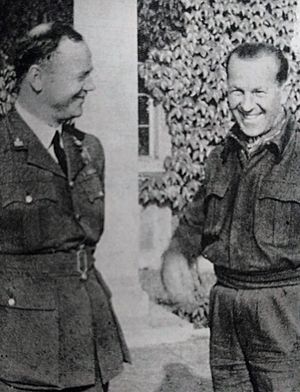Stefan Witorzeńć facts for kids
Quick facts for kids
Stefan Witorzeńć
DFC
|
|
|---|---|

Witorzenc (left) and Stefan Janus (right)
|
|
| Born | 2 January 1908 Lida, Russian Empire |
| Died | 30 December 1994 (aged 86) Warsaw |
| Allegiance | Poland United Kingdom |
| Service/ |
Polish Air Force Royal Air Force |
| Rank | Group Captain |
| Service number | 76730 |
| Unit | No. 501 Squadron RAF No. 306 Polish Fighter Squadron No. 302 Polish Fighter Squadron |
| Commands held | No. 306 Polish Fighter Squadron No. 302 Polish Fighter Squadron No. 133 Wing RAF |
| Battles/wars | Polish Defensive War, World War II |
| Awards | Virtuti Militari; Cross of Valour; Distinguished Flying Cross (United Kingdom); Order of Polonia Restituta |
Stefan Witorzeńć (born January 2, 1908 – died December 30, 1994) was a brave Polish pilot. He was a fighter ace in the Polish Air Force during World War II. This means he shot down at least five enemy planes. He was known for his courage and skill in the air.
Contents
Stefan Witorzeńć's Early Life and Training
Stefan Witorzeńć was born in 1908 into a noble family. He wanted to serve his country. In 1930, he finished a special school for army officers. Two years later, in 1932, he graduated from the Polish Air Force Academy. This was a big step towards becoming a pilot.
After his training, he worked in the 3rd Aviation Regiment in a city called Poznań. Later, he became an instructor. He taught other pilots at the Higher Pilot School in Grudziądz.
Fighting in World War II
When World War II started in 1939, Stefan Witorzeńć was ready to defend his homeland. During the September Campaign, he helped protect the Dęblin region in Poland. As the war continued, he had to leave Poland. He traveled through Romania and France to reach the United Kingdom.
In the UK, he joined the Royal Air Force (RAF). On August 6, 1940, he joined No. 501 Squadron RAF. Here, he flew alongside another famous pilot, Stanisław Skalski.
The Battle of Britain
Stefan Witorzeńć played a key role in the Battle of Britain. This was a huge air battle where British and Allied pilots fought against German planes. During this time, Witorzeńć shot down four enemy planes and shared credit for another. On August 18, 1940, he even shot down a German ace pilot named Horst Tietzen.
After his success, he moved to the No. 306 Polish Fighter Squadron on November 17, 1940. Just five days later, he became the leader of "A flight" in that squadron. In March 1941, he was promoted to captain.
Leading Other Squadrons
Stefan Witorzeńć continued to rise through the ranks. On May 14, 1941, he moved to the No. 302 Polish Fighter Squadron. By May 27, he was the commander of this squadron. His leadership skills were clearly recognized.
Later, on November 24, 1941, he was given command of the No. 133 Wing RAF. This was a larger group of squadrons. For his bravery and skill, he received the Distinguished Flying Cross (United Kingdom) on June 1, 1942.
From September 1942 to April 1944, he worked as a liaison officer. This meant he helped connect different groups. He also became a training director, helping to teach new pilots. In August 1944, he returned to command the No. 133 Wing RAF. He continued to fly combat missions during this time.
After the War
On January 7, 1945, Stefan Witorzeńć became the commander of a training school for new pilots. After the war ended, he returned to Poland in 1948.
It was not until 1957 that he was allowed to rejoin the Polish People's Army Air Force. This was after a difficult period in Poland's history. He served in the Air Force Command. Then, he commanded the Air Training Centre in Modlin. In 1968, he retired from military service.
In 1991, he became the president of the Polish Air Force Association. This group helps connect former Polish Air Force members. Stefan Witorzeńć passed away on December 30, 1994. He is buried in the Powązki Cemetery in Warsaw.
His Amazing Air Victories
Here are some of the enemy planes Stefan Witorzeńć shot down or helped to damage:
- Bf 110 - August 12, 1940 (damaged, meaning he hit it but it wasn't completely destroyed)
- 2 x Ju 87 – August 15, 1940
- Bf 109 – August 18, 1940
- Ju 88 - August 24, 1940 (damaged)
- Do 215 – September 2, 1940
- Half of a Do 215 – September 11, 1940 (meaning he shared the credit for shooting it down with another pilot)
- Bf 109 – September 4, 1941
Awards and Honors
Stefan Witorzeńć received many important awards for his bravery and service:





